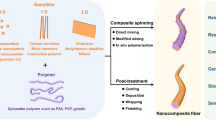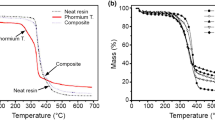Abstract
The fragmentation of a single fiber embedded in a polymer matrix upon stretching (SFC test) provides valuable information on the fiber-matrix bond strength (τ), which determines stress transfer through the interface and, thus, significantly affects the mechanical properties of the composite material. However, the calculated bond strength appears to depend on data interpretation, i.e., on the applied theoretical model, since the direct result of the SFC test is the fiber fragment length distribution rather than the τ value. Two approaches are used in SFC testing for calculation of the bond strength: 1) the Kelly-Tyson model, in which the matrix is assumed to be totally elastic and 2) the Cox model using the elastic constants of the fiber and the matrix. In this paper, an attempt has been made to compare these two approaches employing theory as well as the experimental data of several authors. The dependence of the tensile stress in the fiber and the interfacial shear stress on various factors has been analyzed. For both models, the mean interfacial shear stress in the fragment of critical length (lc) was shown to satisfy the same formula (τ) = (σcD)/2lc, where D is the fiber diameter and σc is the tensile strength of a fiber at gauge length equal to lc. However, the critical lengths from the Kelly-Tyson approach and Cox model are differently related to the fragment length distribution parameters such as the mean fragment length. This discrepancy results in different (τ) values for the same experimental data set. While the main parameter in the Kelly-Tyson model assumed constant for a given fiber-matrix pair is the interfacial shear strength, the ultimate (local) bond strength τult may be seen as the corresponding parameter in the Cox model. Various τult values were obtained for carbon fiber-epoxy matrix systems by analyzing the data of continuously monitored single fiber composite tests. Whereas the mean value of the interfacial shear stress calculated in the Cox approach was comparable to the interfacial shear strength from the Kelly-Tyson model, its ultimate value characterizing the true adhesional bond strength appeared to be three or four times greater.
Similar content being viewed by others
References
S. F. Zhandarov, E. V. Pisanova, and V. A. Dovgyalo, “Tensile fragmentation of a single fiber in a matrix as a method for determining adhesion,” Mekh. Kompozitn. Mater., No. 3, 384–403 (1992).
V. P. Tamuzh, Yu. G. Korabel'nikov, I. A. Rashkovan, A. A. Karklin'sh, Yu. A. Gorbatkina, and T. Yu. Zakharova, “Determination of the scalar dependence of the strength of fiber fillers and evaluation of their adhesion to a matrix by testing single fibers in a polymer block,” Mekh. Kompozitn. Mater., No. 4, 641–647 (1991).
B. Yavin, H. E. Gallis, J. Scherf, A. Eitan, and H. D. Wagner, “Continuous monitoring of the fragmentation phenomenon in single fiber composite materials,” Polymer Composites,12, No. 6, 436–446 (1991).
M. J. Pitkethly, J. P. Favre, U. Gaur, J. Jakubowski, S. F. Mudrich, D. L. Caldwell, L. T. Drzal, M. Nardin, H. D. Wagner, L. Di Landro, A. Hampe, J. P. Armistead, M. Desaeger, and I. Verpoest, “A round-robin programme on interfacial test methods,” Composites Sci. Technol.,48, 205–214 (1993).
D. Jacques and J.-P. Favre, “Modelisation statistique du processus de fragmentation dans les composites-modeles a monofilament,” JNC 6, Contes Rendus Sixiemes Journees Nat. Compos., Paris (1988), pp. 169–182.
A. Kelly and W. R. Tyson, “Tensile properties of fibre-reinforced metals: copper/tungsten and copper/molybdenum,” J. Mech. Phys. Solids,13, 329–350 (1965).
A. T. DiBenedetto, “Evaluation of fiber surface treatments in composite materials,” Pure Appl. Chem.,57, No. 11, 1659–1665 (1985).
R. B. Henstenburg and S. L. Phoenix, “Interfacial shear strength studies using the single-filament-composite test. Part II: A probability model and Monte Carlo simulation,” Polymer Composites,10, No. 5, 389–408 (1989).
H. L. Cox, “The elasticity and strength of paper and other fibrous materials,” Br. J. Appl. Phys.,3, 72–79 (1952).
V. V. Bolotin and V. P. Tamuzh, “Length distribution of fragmented fibers in monodirectional composites,” Mekh. Kompozitn. Mater., No. 6, 1107–1110 (1982).
S. S. Abramchuk and V. D. Protasov, “Effect of the interaction of parallel cracks in composites on the distribution of the distance between them,” Mekh. Kompozitn. Mater., No. 3, 430–439 (1991).
T. Ohsawa, A. Nakayama, M. Miwa, and A. Hasegawa, “Temperature dependence of critical fiber length for glass fiber-reinforced thermosetting resins,” J. Appl. Polymer Sci.,22, 3203–3212 (1978).
E. V. Pisanova, S. F. Zhandarov, and V. A. Dovgyalo, “Interfacial adhesion and failure modes in single filament thermoplastic composites,” Polymer Composites,15, No. 1, 147–155 (1994).
P. Feillard, G. Desarmot, and J. P. Favre, “A critical assessment of the fragmentation test for glass/epoxy systems,” Composites Sci. Technol.,49, 109–119 (1993).
Yu. A. Gorbatkina, Adhesive Strength in Polymer-Fiber Systems [in Russian], Moscow (1987).
J.-P. Favre, P. Sigety, and D. Jacques, “Stress transfer by shear in carbon fibre model composites. Part II: Computer simulation of the fragmentation test,” J. Materials Sci.,26, 189–195 (1991).
M. R. Piggott, P. S. Chua, and D. Anderson, “The interface between glass and carbon fibers and thermosetting polymers,” Polymer Composites,6, No. 4, 242–248 (1985).
W. Weibull, A Statistical Theory of Strength of Materials, Stockholm (1959).
Author information
Authors and Affiliations
Additional information
Translated from Mekhanika Kompozitnykh Materialov, Vol. 31, No. 4, pp. 446–461, July–August, 1995.
Rights and permissions
About this article
Cite this article
Zhandarov, S.F., Pisanova, E.V. Two interfacial shear strength calculations based on the single fiber composite test. Mech Compos Mater 31, 325–336 (1996). https://doi.org/10.1007/BF00632619
Received:
Revised:
Issue Date:
DOI: https://doi.org/10.1007/BF00632619




